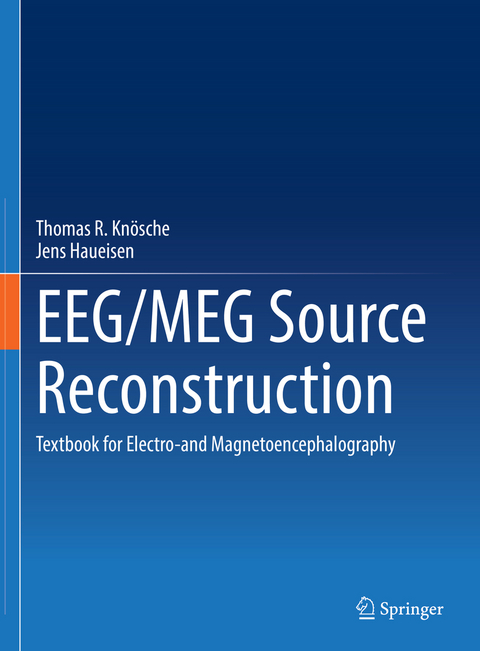
EEG/MEG Source Reconstruction
Springer International Publishing (Verlag)
978-3-030-74916-3 (ISBN)
This textbook provides a comprehensive and didactic introduction from the basics to the current state of the art in the field of EEG/MEG source reconstruction. Reconstructing the generators or sources of electroencephalographic and magnetoencephalographic (EEG/MEG) signals is an important problem in basic neuroscience as well as clinical research and practice. Over the past few decades, an entire theory, together with a whole collection of algorithms and techniques, has developed.
In this textbook, the authors provide a unified perspective on a broad range of EEG/MEG source reconstruction methods, with particular emphasis on their respective assumptions about sources, data, head tissues, and sensor properties. An introductory chapter highlights the concept of brain imaging and the particular importance of the neuroelectromagnetic inverse problem. This is followed by an in-depth discussion of neural information processing and brain signal generation and an introduction to the practice of data acquisition. Next, the relevant mathematical models for the sources of EEG and MEG are discussed in detail, followed by the neuroelectromagnetic forward problem, that is, the prediction of EEG or MEG signals from those source models, using biophysical descriptions of the head tissues and the sensors. The main part of this textbook is dedicated to the source reconstruction methods. The authors present a theoretical framework of the neuroelectromagnetic inverse problem, centered on Bayes' theorem, which then serves as the basis for a detailed description of a large variety of techniques, including dipole fit methods, distributed source reconstruction, spatial filters, and dynamic source reconstruction methods. The final two chapters address the important topic of assessment, including verification and validation of source reconstruction methods, and their actual application to real-world scientific and clinical questions.This book is intended as basic reading foranybody who is engaged with EEG/MEG source reconstruction, be it as a method developer or as a user, including advanced undergraduate students, PhD students, and postdocs in neuroscience, biomedical engineering, and related fields.
lt;p>Thomas R. Knösche received his diploma in Electrical Engineering in 1992 from Ilmenau University of Technology (Germany), and his PhD in Applied Physics in 1997 from the University of Twente (Netherlands). Then, he pursued postdoctoral research in the lab of Angela Friederici at the Max Planck Institute for Cognitive Neuroscience (Leipzig, Germany). In 1999, he joined ANT Software (Enschede, Netherlands) to work on EEG/MEG source reconstruction. In 2001, he rejoined the Max Planck Institute. Since 2006 he is head of the Brain Networks group, in 2010 he obtained his habilitation (professoral thesis), and since 2018 he holds a honorary professorship at Ilmenau University of Technology. His research interests include source reconstruction and connectivity estimation from EEG and MEG, mathematical modeling of neuronal networks, and estimation of structural connectivity based on magnetic resonance imaging.
Jens Haueisen received a M.S. and a Ph.D. in electrical engineering from the Technische Universität Ilmenau, Germany, in 1992 and 1996, respectively. From 1996 to 1998 he worked as a Post-Doc and from 1998 to 2005 as the head of the Biomagnetic Center, Friedrich-Schiller-University, Jena, Germany. In 2003 he received the habilitation (professorial thesis). Since 2005 he is full Professor of Biomedical Engineering and directs the Institute of Biomedical Engineering and Informatics at the Technische Universität Ilmenau, Germany. His research interests include the investigation of active and passive bioelectric and biomagnetic phenomena.
Chapter 1: Introduction.- Chapter 2: Neural Tissue and its Signals.- Chapter 3: Measurements.- Chapter 4: Source Models.- Chapter 5: Forward Models.- Chapter 6: Inverse Methods.- Chapter 7: Assessment.- Chapter 8: Applications.
| Erscheinungsdatum | 05.10.2022 |
|---|---|
| Zusatzinfo | XIX, 415 p. 174 illus. in color. |
| Verlagsort | Cham |
| Sprache | englisch |
| Maße | 210 x 279 mm |
| Gewicht | 1298 g |
| Themenwelt | Medizin / Pharmazie ► Physiotherapie / Ergotherapie ► Orthopädie |
| Medizin / Pharmazie ► Studium | |
| Naturwissenschaften ► Biologie ► Humanbiologie | |
| Naturwissenschaften ► Biologie ► Zoologie | |
| Technik ► Maschinenbau | |
| Technik ► Medizintechnik | |
| Schlagworte | EEG • Electromagnetic source imaging • MEG • Source Localization • Source reconstruction |
| ISBN-10 | 3-030-74916-9 / 3030749169 |
| ISBN-13 | 978-3-030-74916-3 / 9783030749163 |
| Zustand | Neuware |
| Informationen gemäß Produktsicherheitsverordnung (GPSR) | |
| Haben Sie eine Frage zum Produkt? |
aus dem Bereich


